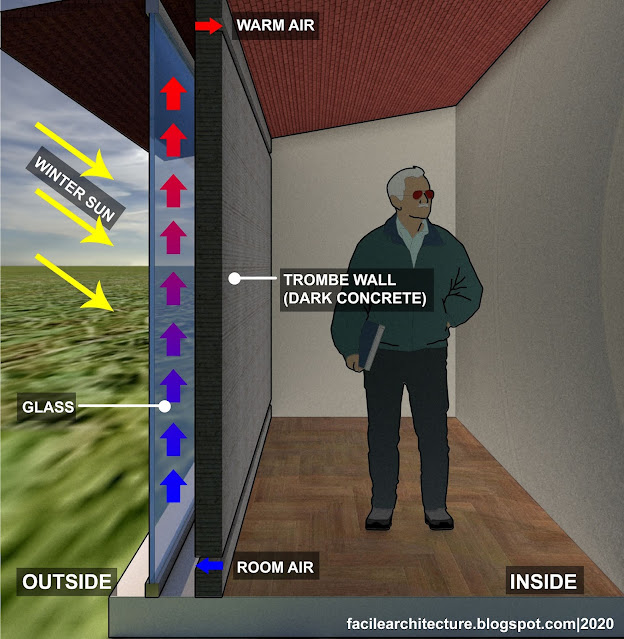 |
| Trombe wall |
A Trombe wall is a south-facing masonry wall (for Northern hemisphere) covered with glass spaced a few inches away. Sunlight passes through the glass and is absorbed and stored by the wall.
The wall has vents provided at both upper and lower parts for air circulation. The glass and airspace keep the heat from radiating back to the outside.
Heat is transferred by conduction as the masonry surface (i.e Trombe wall) warms up, and is slowly delivered to the building some hours later.
ORIGIN
The Trombe wall builds on the idea of utilizing a space in the building to conserve energy. This was developed by Felix Trombe in the 1950s and was first used in the south of France.
PASSIVE SOLAR BUILDING DESIGN
The inclusion of Trombe walls reduces the amount of energy used to heat the home. Trombe walls are a way to achieve energy efficient building design.
These walls are beneficial as they require little to no effort to operate and are ideal for spaces where silences and privacy are desirable.
These walls are built of some dark-coloured material - sometimes concrete - that is built facing the Sun so that the solar radiation is incident on this wall.
MATERIAL
MASONRY
Any materials that have a high thermal capacity can be used in the Trombe wall.
Concrete, terracotta and limestone are the most advantageous inertial materials for use in housing: they offer simultaneously a fairly high thermal storage capacity, low energy consumption during the production process and low cost .
To accumulate heat during the day it is recommended to orient concrete, stone or brick walls, to the most exposed side to the sun during the year.
Trombe wall of 30-40cm thick concrete in many geographical locations works well. The finishing of the Trombe wall is very important for the efficiency of this system. Coating materials with a high degree of absorption contributes to the improved storage of heat in the Trombe wall.
Dark colors are recommended because they absorb much more energy.
GLAZING
The distance between the glass and the thermal mass is usually between 3-6 cm.
From the economic point of view it is justified to use a double glazing in combination with a 30 cm thick thermal mass.
It is also preferable to apply a combination of 20 cm thick thermal mass and a single glazing.
The thermal mass made of 45 cm thick wall in combination with single glazing is also a better option compared to a 20 cm thick thermal mass combined with a triple glazing.
|
ADVANTAGES
|
DISADVANTAGES
|
-
performs better at maintaining a steady indoor temperature than other indirect-gain heating systems.
|
-
It is a very climate-dependent.
|
-
simple configuration, high efficiency, zero running cost.
|
-
It is a user-dependent system as well that can be a liability to operate movable insulation or shutters in a daily basis.
|
-
can reduce a building’s energy consumption up to 30% in addition to being environmentally friendly.
|
-
Visual access to the outside is lost in the full-height Trombe walls.
|
-
The energy heating savings of 16.36% can be achieved if a Trombe wall is added to the building envelope.
|
-
Wall hangings or other type of coverings are not allowed on Trombe walls.
|
-
No Glare, ultraviolet degradation, or reduction of night time.
|
-
in regions closer to the equator is open to question.
|
- Energy delivery to a living space is more controllable.
|
-
spaces behind the Trombe walls should contain openings on the other walls of the room to provide daylight and prevent it from being dim.
|
-
reduces the overall labor and material cost of constructing a passively heated building.
|
- it is necessary to use back-draft dampers.
|
-
can be the load-bearing structure of the buildings, so each floor’s south-facing facade can take the advantage of the Trombe wall system.
|
-
its impact on the overall building design is limited since the Trombe wall is consolidated in the south-facing façade only.
|
-
useful for commercial buildings with significant internal loads.
|
-
it displays the poorest economic performance due to the scarcest solar radiation during the heating season.
|
Source:
Hope you enjoyed the article | Click here to follow the blog Click
here to read similar posts
Click
here to see my substandard artwork 🙈




Comments
Post a Comment